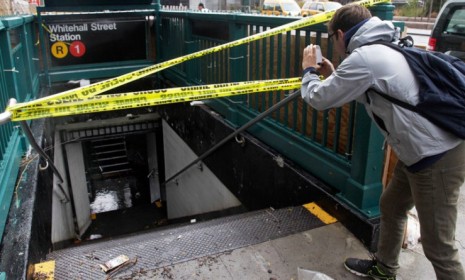Hurricane Sandy: What New York needs to do to get back on track
The superstorm shut down Gotham schools and offices, downed trees and power lines, and stopped flights and public transit — and recovery will take time

New Yorkers are a famously resilient bunch, but they'll have to be extra resourceful in the wake of superstorm Sandy, which slammed the country's biggest metropolis, resulting in public transit closures, power outages, and fires, as well as the shuttering of all public schools and a number of offices. What steps will New York City have to take to get back to normal? Here, a guide:
1. Restoring power
Superstorm Sandy led to 660,000 power failures in the United States, roughly 250,000 of which resulted from a fiery explosion at a substation on Manhattan's East 14th Street. Con Edison said the power failures were "the largest storm-related outage" in the company's history, reports The New York Times. While most of Manhattan should have power restored by the end of Tuesday, it could take as long as a week to re-equip everyone with service.
The Week
Escape your echo chamber. Get the facts behind the news, plus analysis from multiple perspectives.

Sign up for The Week's Free Newsletters
From our morning news briefing to a weekly Good News Newsletter, get the best of The Week delivered directly to your inbox.
From our morning news briefing to a weekly Good News Newsletter, get the best of The Week delivered directly to your inbox.
2. Cleaning the subway system
"The New York City subway system is 108 years old, but it has never faced a disaster as devastating as what we experienced last night," said Metropolitan Transportation Authority (MTA) chairman Joseph Lhota in a statement on Tuesday. All seven subway tunnels connecting Manhattan to Queens and Brooklyn took in saltwater, and any damage that the system’s electrical components sustained will necessitate cleaning — sometimes off-site — before the system can be restored, reports Reuters. MTA spokeswoman Deidre Parker predicts that New Yorkers will have to rely on a combination of limited subway and bus service as the system is "gradually" restored.
3. Ungrounding flights
The superstorm has already led to 15,000 grounded flights across the globe, as the ripple effect continues to spread after the mandated closures of the city's JFK, LaGuardia, and Newark airports — which typically serve one-quarter of all U.S. flights on an average day. Angela Gittens, the director general of the Airports Council International, told The Washington Post that even if the storm damage turns out to be minor, it could be more than a week before normal service is restored.
A free daily email with the biggest news stories of the day – and the best features from TheWeek.com
4. Cleaning up downed trees
Brooklyn's Prospect Park and numerous other New York parks resemble a "tree graveyards," with hundreds of downed trees awaiting the attention of cleanup crews, says the Associated Press. Many blocks have also been closed to traffic due to fallen trees. In a Tuesday press conference, Mayor Bloomberg stressed that residents can call or text 311 to report downed trees in their area.
5. Repairing the One57 crane
Though the numerous construction cranes currently suspended in New York City were inspected for safety in advance of the storm, one atop a nearly completed, 90-floor luxury apartment building in midtown Manhattan collapsed in high winds, necessitating evacuation of the area due to concerns that the crane might crash to the ground. "We are working with structural engineers and the D.O.B. [Department of Buildings] on evaluating any additional measures that can be taken to secure the boom and crane structure," said contractor spokeswoman Mary Costello to the Chicago Tribune.
-
 NASA discovered 26 microbes in their cleanrooms
NASA discovered 26 microbes in their cleanroomsUnder the radar The bacteria could contaminate space
-
 The elite falcon trade in the Middle East
The elite falcon trade in the Middle EastUnder the Radar Popularity of the birds of prey has been ‘soaring’ despite doubts over the legality of sourcing and concerns for animal welfare
-
 A running list of the international figures Donald Trump has pardoned
A running list of the international figures Donald Trump has pardonedin depth The president has grown bolder in flexing executive clemency powers beyond national borders